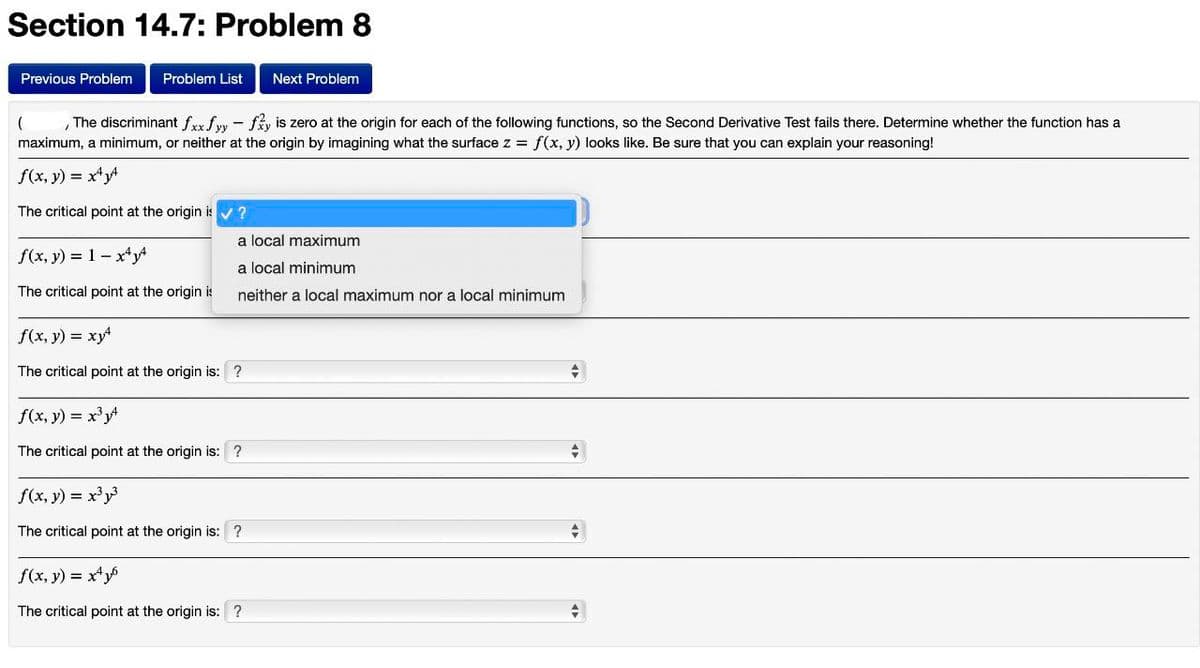( The discriminant fxx fyy-fy is zero at the origin for each of the following functions, so the Second Derivative Test fails there. Determine whether the function has a maximum, a minimum, or neither at the origin by imagining what the surface z = f(x, y) looks like. Be sure that you can explain your reasoning! f(x, y) = x¹y4 The critical point at the origin is? f(x, y) = 1- x¹y4 The critical point at the origin is a local maximum a local minimum neither a local maximum nor a local minimum f(x, y) = xy² The critical point at the origin is: ? f(x, y) = x³y4 The critical point at the origin is: ? f(x, y) = x³y³ The critical point at the origin is: ? f(x, y) = x¹y6 The critical point at the origin is: ? # # +
( The discriminant fxx fyy-fy is zero at the origin for each of the following functions, so the Second Derivative Test fails there. Determine whether the function has a maximum, a minimum, or neither at the origin by imagining what the surface z = f(x, y) looks like. Be sure that you can explain your reasoning! f(x, y) = x¹y4 The critical point at the origin is? f(x, y) = 1- x¹y4 The critical point at the origin is a local maximum a local minimum neither a local maximum nor a local minimum f(x, y) = xy² The critical point at the origin is: ? f(x, y) = x³y4 The critical point at the origin is: ? f(x, y) = x³y³ The critical point at the origin is: ? f(x, y) = x¹y6 The critical point at the origin is: ? # # +
Algebra & Trigonometry with Analytic Geometry
13th Edition
ISBN:9781133382119
Author:Swokowski
Publisher:Swokowski
Chapter11: Topics From Analytic Geometry
Section11.3: Hyperbolas
Problem 42E
Related questions
Question

Transcribed Image Text:Section 14.7: Problem 8
Previous Problem Problem List Next Problem
(
The discriminant fxx fyy-fy is zero at the origin for each of the following functions, so the Second Derivative Test fails there. Determine whether the function has a
maximum, a minimum, or neither at the origin by imagining what the surface z = f(x, y) looks like. Be sure that you can explain your reasoning!
f(x, y) = x¹y4
The critical point at the origin is ✓ ?
f(x, y) = 1 - x¹y4
The critical point at the origin is
a local maximum
a local minimum.
neither a local maximum nor a local minimum
f(x, y) = xy4
The critical point at the origin is: ?
f(x, y) = x³y4
The critical point at the origin is: ?
f(x, y) = x³y³
The critical point at the origin is: ?
f(x, y) = x²y6
The critical point at the origin is: ?
#
+
+
Expert Solution
This question has been solved!
Explore an expertly crafted, step-by-step solution for a thorough understanding of key concepts.
Step by step
Solved in 2 steps

Recommended textbooks for you

Algebra & Trigonometry with Analytic Geometry
Algebra
ISBN:
9781133382119
Author:
Swokowski
Publisher:
Cengage

Algebra & Trigonometry with Analytic Geometry
Algebra
ISBN:
9781133382119
Author:
Swokowski
Publisher:
Cengage